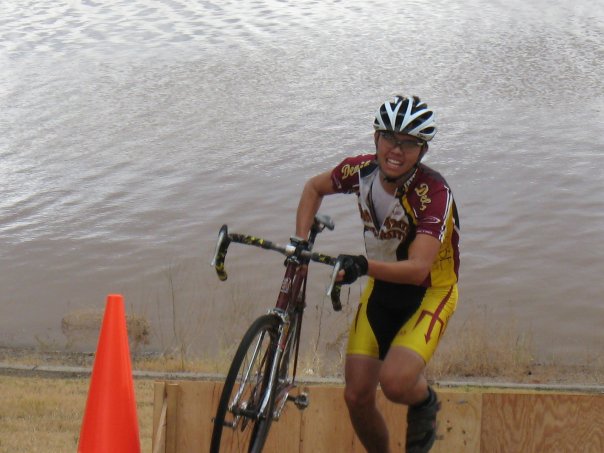
ASUCTC President Nikolai Skievaski shows the proper technique when going over a barrier.
In Arizona it's easy to take 'cross for granted, in much the same way we take winter for granted. It's the brief vacation from the monotony of road racing and the heat of an 8 month summer. Before you know it, it's gone. At least, that's the way it is for people who get excited by cyclocross. For many, it's an obscure word that has very little meaning. In the subculture of cycling, it's the subculture's subculture (Maybe a little bit like indoor cycling or offroad unicycling)
According to Wikipedia, cyclocross finds its origin in Europe where, "road racers in the early 1900s would race each other to the next town over from them and that they were allowed to cut through farmer's fields, over fences or take any other shortcuts in order to make it to the next town first. This was a way for them to stay in shape during the winter months and put a twist on road racing. In addition, riding off road in more difficult conditions than smooth pavement increased the intensity at which the cyclists were riding and improved their on-the-road bike handling abilities."
A lot has changed from its origin. Now cyclocross is a full on organized winter sport with some athletes making their entire career focus strictly on racing cross. The most popular example of this is Belgian Sven Nys(video).
Equipment is a lot different as well. Nowadays there are special bikes made especially for cyclocross. The frames of these bikes are made to allow for clearance of larger tires than would be normally used on the road. Components are usually the same as on road bikes, except 'cross bikes use old style cantilever brakes. These brakes suck at stopping, but they give plenty of clearance for the larger tires and mud. Go here to read and look at pictures from cyclingnews' write up of American Jonathan Page's bike last year.
Now, the racing. Basically, a 'cross race is structured similar to a criterium would be on the road. There is a set course that racers go over, and the racers are racing for a certain amount of time not distance. The similarities end there though, because a cyclocross course is mostly done off-road. Along with the terrain, courses usually have many sharp turns that test a riders bike handling skills. There are also barriers and run-ups, which usually require a racer to dismount, and run with their bike in order to clear efficiently -- usually.
Now you know a little bit about cyclocross. The AZ season starts this Sunday, and it should be fun.
-Anthony
No comments:
Post a Comment